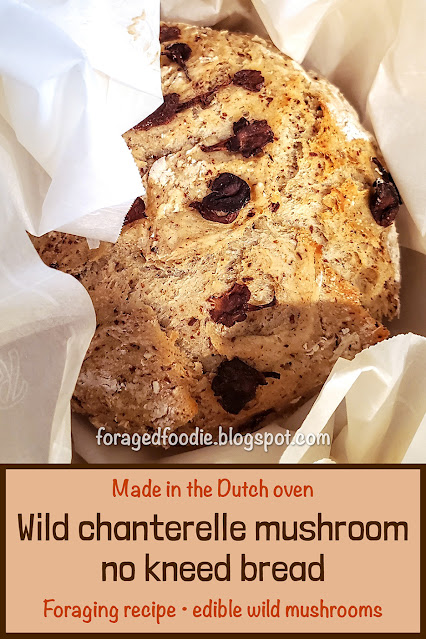 |
The long flower stalks of curly dock
can be cooked like asparagus |
Curly dock, Rumex crispus, is one of the most versatile and abundant wild plants around. The broad, vitamin-rich leaves are the most-known part of the plant, and can be used like spinach or kale.
As a biannual plant, curly dock produces only energy-gathering leaves over its first growing season. During the second season, the plant will shoot up a central stalk that will flower and eventually go to seed.
These stalks are a very tasty and unique vegetable, similar in texture to asparagus, but with a sour/tart flavor, more pronounced than the leaves, but less than lemon or rhubarb. Due to the look and the texture, foragers sometimes call this part of the plant "docksparagus".
For dinner last weekend used made teriyaki-marinated, steak-wrapped wild veggie bundles, topped with a teriyaki glaze, inspired by negimaki. I used docksparagus, wild garlic scapes, and some bell peppers for color and texture. The rolls were very easy and quick to put together, not counting marinade time, with a pretty early clean up as well.
You can even do the bulk of the work (preparing the marinade) in advance, and store in the fridge.
They came out delicious, while still being healthy: low calorie, keto / low carb, full of nutrients, and dairy-free.
 |
Using the bulbils of wild garlic is super easy:
no peeling required! |
I opted to use wild garlic bulbils (i've been calling them bulbettes al this time) heads instead of store-bought garlic here. I love using this garlic stage, it's so easy. The skins on the garlic bulbils are so incredibly thin you don't have to peel them for cooked applications, just mince everything -- bulbils, skins, flowers, stalks, flower stalks -- together and use in place of commercial garlic.
Teriyaki steak rolls with wild plants
Makes around 12 rolls
2lbs sirloin, flank, top or bottom round, sliced to 1/8 thick
24 long, thin docksparagus stalks, remove tough or dried-out leaves
1 red, yellow or orange bell pepper, or 2 half peppers for variety
Around 36 wild garlic scapes&
For the marinade / glaze
Beef stock 3/4 cup
Soy sauce 1/2 cup
Rice wine vinegar 1/2 cup
Garlic chili oil 1/4 cup, more or less for your spice level
Olive oil 1/4 cup
Sesame oil 2 tbs
Whole bulb garlic or equivalent wild garlic, minced
2tbs fresh grated ginger
1 tsp white pepper
1 tsp. corn starch or other thickener
- Mix all marinade ingredients together in a large bowl or 9x12 baking pan.
- Add in the sliced beef and marinade at least one hour, or overnight. Marinade in the fridge if marinating longer than a couple of hours.
- If you've marinaded in the fridge, remove and allow the beef to come to room temperature before cooking
- Preheat the oven to 375.
- Cut the docksparagus and garlic scapes into spears around 4inches long. Slice the bell peppers into long strips.
- Line a baking sheet with parchment paper. Remove the sliced beef from the marinade and lay out on the parchment. Do not discard the marinade
 |
Next time I would only use garlic scapes inside the rolls,
no garlic heads with bulbils |
- Place a mix of veggies on each strip of beef. I used 2 bell pepper slices, 3-4 docksparagus spears and 3-4 garlic scape pieces.*
- Roll the beef around the veggies and fasten with a toothpick. Repeat for all beef slices. Drizzle with marinade.
- Roast in the oven for 15 minutes, then flip each roll and roast for another 10 minutes.
- While the rolls are roasting, bring remaining marinade to a rolling boil over high heat. Boil for at least 2 minutes.
 |
For real though, remove the toothpicks before serving.
Don't make the same mistakes I did |
- Mix 1 tsp. Corn starch in a small amount of water. Add to the boiling marinade and reduce heat to medium. Allow to thicken, stirring, and remove from heat.
- Remove the rolls from the oven, plate, REMOVE THE TOOTHPICKS and cover with the teriyaki glaze. Serve hot.
*Special note about the wild garlic. Right now north Texas wild garlic is in a variety of stages: garlic scape (one enclosed bulb at the top of the stalk), flowering and bulbils, the post-flowering mini-bulbettes at the top of the stalk. The bulbils are excellent in the marinade or in any other minced application, however, they are too thick to cook all the way through if you use them (as I did) inside the rolls. Next time I will definitely keep to the scapes inside the rolls and the bulbils only in the marinade, as they were just a bit undercooked inside the rolls.
Obligatory note on curly dock. Rumex crispus contains substantial amounts of oxalic acid. While there are many commercially grown plants that contain oxalic acid, curly dock may have a larger content. Oxalic acid should be only eaten by healthy people in moderation. (If I do a meal prep with curly dock, I will generally only eat the meals every other day, rather than every day.) People with kidney or liver issues -- especially a tendency for kidney stones -- should avoid oxalic acid, as should breast-feeding women, it can have a laxative effect that can be passed to the baby through the milk.





















